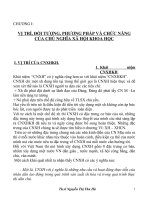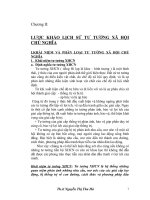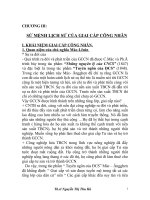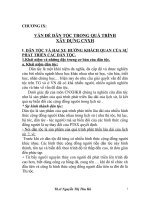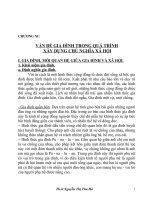Green Warriors doc
Bạn đang xem bản rút gọn của tài liệu. Xem và tải ngay bản đầy đủ của tài liệu tại đây (1.96 MB, 254 trang )
This document and trademark(s) contained herein are protected by law as indicated
in a notice appearing later in this work. This electronic representation of RAND
intellectual property is provided for non-commercial use only. Unauthorized
posting of RAND PDFs to a non-RAND Web site is prohibited. RAND PDFs are
protected under copyright law. Permission is required from RAND to reproduce,
or reuse in another form, any of our research documents for commercial use. For
information on reprint and linking permissions, please see RAND Permissions.
Limited Electronic Distribution Rights
Visit RAND at www.rand.org
Explore RAND Arroyo Center
View document details
For More Information
This PDF document was made available
from www.rand.org as a public service of
the RAND Corporation.
6
Jump down to document
THE ARTS
CHILD POLICY
CIVIL JUSTICE
EDUCATION
ENERGY AND ENVIRONMENT
HEALTH AND HEALTH CARE
INTERNATIONAL AFFAIRS
NATIONAL SECURITY
POPULATION AND AGING
PUBLIC SAFETY
SCIENCE AND TECHNOLOGY
SUBSTANCE ABUSE
TERRORISM AND
HOMELAND SECURITY
TRANSPORTATION AND
INFRASTRUCTURE
WORKFORCE AND WORKPLACE
The RAND Corporation is a nonprofit
research organization providing
objective analysis and effective
solutions that address the challenges
facing the public and private sectors
around the world.
Purchase this document
Browse Books & Publications
Make a charitable contribution
Support RAND
This product is part of the RAND Corporation monograph series.
RAND monographs present major research findings that address the
challenges facing the public and private sectors. All RAND mono-
graphs undergo rigorous peer review to ensure high standards for
research quality and objectivity.
Prepared for the United States Army
Approved for public release; distribution unlimited
ARROYO CENTER
Green Warriors
Army Environmental Considerations
for Contingency Operations
from Planning Through Post-Conflict
David E. Mosher, Beth E. Lachman, Michael D. Greenberg,
Tiffany Nichols, Brian Rosen, Henry H. Willis
The RAND Corporation is a nonprofit research organization providing
objective analysis and effective solutions that address the challenges
facing the public and private sectors around the world. R AND’s
publications do not necessarily reflect the opinions of its research clients
and sponsors.
R
®
is a registered trademark.
© Copyright 2008 RAND Corporation
All rights reserved. No part of this book may be reproduced in any
form by any electronic or mechanical means (including photocopying,
recording, or information storage and retrieval) without permission in
writing from RAND.
Published 2008 by the RAND Corporation
1776 Main Street, P.O. Box 2138, Santa Monica, CA 90407-2138
1200 South Hayes Street, Arlington, VA 22202-5050
4570 Fifth Avenue, Suite 600, Pittsburgh, PA 15213-2665
RAND URL:
To order RAND documents or to obtain additional information, contact
Distribution Services: Telephone: (310) 451-7002;
Fax: (310) 451-6915; Email:
The research described in this report was sponsored by the United States
Army under Contract No. DASW01-01-C-0003.
Library of Congress Cataloging-in-Publication Data
Green warriors : Army environmental considerations for contingency operations from
planning through post-conflict / David E. Mosher [et al.].
p. cm.
Includes bibliographical references.
ISBN 978-0-8330-4318-4 (pbk. : alk. paper)
1. United States. Army—Foreign service—Environmental aspects. 2. United
States. Army—Operations other than war—Environmental aspects. 3. Postwar
reconstruction—Environmental aspects. 4. Military doctrine—United States—
Environmental aspects. 5. Environmental policy—United States. I. Mosher,
David E. II. Mosher, David E.
UA25.G85 2008
355.4'1—dc22
2007052096
iii
Preface
Environmental issues have become increasingly important in contin-
gency operations the U.S. Army conducts overseas. Countries in which
the Army conducts operations tend to have environmental problems
caused by industrialization, lack of environmental protection, long-
running conflict, and natural conditions. is situation creates health
and safety risks for soldiers, can affect missions, and can increase the
importance of life-sustaining environmental infrastructures for such
things as clean water, sewage disposal, and agriculture to provide food
for the local populace.
Prompted by the growing importance of environmental consid-
erations in military operations, the Army Environmental Policy Insti-
tute (AEPI) asked RAND to examine how the Army approaches this
issue in overseas contingency operations, particularly during the post-
conflict and reconstruction phases. It also asked RAND to identify
existing problems and gaps in policy, doctrine, and guidance and to
propose solutions the Army could adopt to address them. is report
should be of interest to the environmental community within the
Army, the Office of the Secretary of Defense (OSD), and the other
Services, as well as to other military planners, operators, trainers, and
policymakers.
e report concludes that environmental considerations—includ-
ing clean water, sanitation, hazardous-waste management—can be
important for achieving overall U.S. objectives during reconstruction
and post-conflict operations, including both short- and long-term sta-
bility. If not properly addressed in planning or operations, environmen-
iv Green Warriors: Army Environmental Considerations
tal considerations can increase the costs of an operation and make it
more difficult for the Army to sustain the mission. Yet, environmental
considerations are not well incorporated into Army planning or opera-
tions in any phase of an operation. To address these shortcomings, the
Army should take additional steps to ensure that environmental con-
siderations (from strategic to tactical) are appropriately incorporated
into planning, operations, training, and research.
e research was carried out in RAND Arroyo Center’s Strategy,
Doctrine, and Resources Program. RAND Arroyo Center, part of the
RAND Corporation, is a federally funded research and development
center sponsored by the U.S. Army.
e Project Unique Identification Code (PUIC) for the project
that produced this document is AEPI-04001.
For more information on RAND Arroyo Center, contact the
Director of Operations (telephone 310-393-0411, extension 6419; FAX
310-451-6952; email ), or visit Arroyo’s web
site at />v
Sponsor Guidance
vii
Contents
Preface iii
Sponsor Guidance
v
Figures
xi
Tables and Boxes
xiii
Summary
xv
Acknowledgments
xix
Acronyms
xxi
CHAPTER ONE
Introduction 1
Background
1
Why Should Commanders Care About Environmental Issues in
Contingency Operations?
5
Environmental Issues Can Affect Soldier Health and Safety
5
Environmental Issues Can Affect Mission Success
6
Long-Term Deployments Amplify the Importance of Environmental
Issues
10
e Importance of “Doing the Right ing”
11
e Challenge of Incorporating Environmental Considerations into
Contingency Operations
12
Purpose and Methodology of is Report
13
Structure of is Report
15
viii Green Warriors: Army Environmental Considerations
CHAPTER TWO
e Context for Environmental Considerations in Contingency
Operations 17
Principal Areas of Interaction with the Environment
17
Achieving Strategic Objectives
17
Conducting Tactical Operations
18
Sustaining Forces
18
Providing Humanitarian Assistance
20
Conducting Stabilization and Reconstruction Operations
20
Domestic and International Legal Context
21
Policy Context
25
Presidential Orders and DoD Directives and Regulations
27
Joint Staff and Army Regulations and Guidance
34
e Army Strategy for the Environment
50
Summary of the Policy Context
53
Operational Context
53
Duration of the Operation
54
Objectives and Nature of the Operation
54
Involvement of Other Stakeholders
57
e Environmental Context
59
Severe Degradation of the Local Environment
59
e Importance of Environmental Conditions to the Local Populace
62
Environmental Issues in Contingency Operations Significantly
Different from Issues in the United States
66
CHAPTER THREE
Experience with Environmental Considerations in Contingency
Operations 67
Planning and Guidance in the Field
67
Environmental Considerations in Operation Planning: Annex L
68
Regional Guidance
70
Army Activities in the Field
71
Base Camps
72
Stability and Reconstruction
75
Movement of Forces and Materiel
75
Different Field Activities Have Different Environmental
Considerations
76
Training for Field Operations
76
Environmental Issues in Operational Experience: Case Studies
77
Case Studies of Contingency-Operation Activities with
Environmental Concerns
78
Impact Analysis
81
CHAPTER FOUR
Analysis of Army Operational Experience 95
Environmental Considerations Have a Broad Range of Far-Reaching
Impacts
96
Impacts Across Many Dimensions
96
Impacts Across Many Organizations Inside and Outside the Army
98
Impacts in Many Geographic Areas
99
e Army Is Involved in Many Diverse Reconstruction Activities
with Environmental Components
101
Insufficient Resources Are Available to Fully Address Environmental
Issues
102
Contractors Must Be Carefully Selected and Managed
106
Collaboration with Stakeholders Is Beneficial and Critical
109
Proactive Environmental Practices and Lessons Are Not Being
Transferred to Other Parts of the Army
112
Country-Specific Conditions and Needs Should Be Considered
114
Short- and Long-Term Considerations Need to Be Balanced
116
Environmental Problems May Contribute to Insurgency Problems
119
CHAPTER FIVE
Findings and Recommendations 121
Findings
121
1. Environmental Issues Can Have a Significant Impact on
Operations
122
2. Environmental Considerations Can Be Particularly Important
for Success in the Post-Conflict Phase
123
Contents ix
x Green Warriors: Army Environmental Considerations
3. Environmental Considerations in Contingency Operations Are
Significantly Different from ose in Normal Operations in
the United States
. . . . . . . . . . . . . . . . . . . . . . . . . . . . . . . . . . . . . . . . . . . . . . . . . . . . . . . . . 124
4. Environmental Issues Can Have Far-Reaching Impacts Across
Operations, Army Organizations, and the World
. . . . . . . . . . . . . . . . . . . 125
5. Inadequate Environmental Practices in Contingency Operations
Can Increase Risks and Costs
. . . . . . . . . . . . . . . . . . . . . . . . . . . . . . . . . . . . . . . . . . 126
6. e Army Could Improve Its Understanding of Environmental
Considerations and Better Incorporate em into Plans and
Operations
. . . . . . . . . . . . . . . . . . . . . . . . . . . . . . . . . . . . . . . . . . . . . . . . . . . . . . . . . . . . . . . . 126
7. e Army Has No Comprehensive Approach to Environmental
Considerations in Contingencies, Especially in the Post-Conflict
Phase
. . . . . . . . . . . . . . . . . . . . . . . . . . . . . . . . . . . . . . . . . . . . . . . . . . . . . . . . . . . . . . . . . . . . . . . 128
Recommendations
. . . . . . . . . . . . . . . . . . . . . . . . . . . . . . . . . . . . . . . . . . . . . . . . . . . . . . . . . . . . . . 130
1. Improve the Policy and Guidance for Environmental Considerations
in Contingency Operations
. . . . . . . . . . . . . . . . . . . . . . . . . . . . . . . . . . . . . . . . . . . . . 131
2. Encourage an Environmental Ethic roughout the Army at
Extends to Contingency Operations
. . . . . . . . . . . . . . . . . . . . . . . . . . . . . . . . . . 133
3. Better Incorporate Environmental Considerations into Planning
. . . 133
4. Improve Pre-Deployment and Field Environmental Training
. . . . . . . 137
5. Invest More in Environmental Resources and Good
Environmental Practices for Field Operations
. . . . . . . . . . . . . . . . . . . . . . . . 140
6. Use a “Sustainability” Model for Contingency Operations
. . . . . . . . . . 144
Conclusion
. . . . . . . . . . . . . . . . . . . . . . . . . . . . . . . . . . . . . . . . . . . . . . . . . . . . . . . . . . . . . . . . . . . . . . . 144
APPENDIX
A. Domestic and International Law in Army Contingency
Operations
. . . . . . . . . . . . . . . . . . . . . . . . . . . . . . . . . . . . . . . . . . . . . . . . . . . . . . . . . . . . . . . . . 147
B. e Importance of Environmental Conditions to the Local
Populace in Iraq . . . . . . . . . . . . . . . . . . . . . . . . . . . . . . . . . . . . . . . . . . . . . . . . . . . . . . . . . . . 173
C. Case Studies of Operational Experiences . . . . . . . . . . . . . . . . . . . . . . . . . . . . 191
Glossary of Selected Environmental Terms . . . . . . . . . . . . . . . . . . . . . . . . . . . . . . . 215
Bibliography
. . . . . . . . . . . . . . . . . . . . . . . . . . . . . . . . . . . . . . . . . . . . . . . . . . . . . . . . . . . . . . . . . . . . 219
xi
Figures
1.1. e Interaction Between Deployed Forces and the
Environment
3
2.1. Most Important Environmental Issue Cited by Iraqis 64
2.2. Comparison of Iraqi Views of the Most Important
Environmental Problems to Iraqi Views of What
Coalition Forces Are Working to Improve
65
A.1. Type of Liability 164
B.1. Iraqi Priorities for the Coming Year: Responses to an
ABC News Poll, March 2004
175
B.2. Importance of Environmental Issues to Iraqi Respondents 179
B.3. Environmental Issues Cited as Most Important in First
and Second Responses
180
B.4. Iraqi Respondent Views of Environmental Problems
Coalition Forces Are Working to Improve
182
B.5. Comparison of Iraqi Views of the Most Important
Environmental Problems to Iraqi Views of What
Coalition Forces Are Working to Improve
183
B.6. Urban and Rural Views of Most Important Environmental
Problems
184
B.7. Ethnic and Religious Subgroups’ Views of Most Important
Environmental Problems
185
B.8. Ethnic and Religious Subgroups’ Views of Problems
Coalition Forces Are Working to Improve
186
B.9. Comparison of Iraqi Views in Baghdad and Diyala
Provinces
187
B.10. Comparison of Iraqi Views in Muthanna and Dahuk
Provinces
188
xii Green Warriors: Army Environmental Considerations
B.11. Respondents’ Views on the Importance of Clean
Drinking Water and Whether Coalition Forces Are
Working to Improve the Drinking Water
190
xiii
Tables and Boxes
Tables
2.1. Relevance of Selected Regulations and Publications
to Environmental Considerations in Contingency
Operations
28
2.2. Recent Contingency Operations 55
3.1. Case-Study Database Examples 82
Boxes
1.1. Water Issues Are Often a Key Concern During Post-
Conflict and Reconstruction
9
2.1. e Phases of Contengency Operations 19
2.2. Military Hazardous Wastes 24
2.3. U.S. Environmental Policy Context 26
2.4. Environmental Responsibilities Specified in Joint
Doctrine
36
2.5. Ash Shuaiba Port: e Health Risk for U.S. Troops
from Industrial Pollution
61
3.1. Invasive Species and Prevention Practices 89
xv
Summary
Background and Purpose
Since 1991, the United States has engaged in military operations in
the Middle East, Central Asia, Africa, Europe, the Pacific Basin, and
the Caribbean. In many instances, U.S. forces have remained in these
areas far longer than was initially anticipated. As a result, U.S. forces
have become closely involved in such activities as stability operations,
reconstruction, and nation-building. Frequently, these activities are as
important to accomplishing the long-term U.S. goals as the combat
operations that may have preceded them.
e longer stays and involvement in post-conflict activities have
elevated the importance of environmental considerations in U.S. mili-
tary operations, for a variety of reasons. First, conflicts often occur in
countries where the environment poses risks to U.S. forces. Disease,
polluted air or water, or toxic substances may present a high risk when
the troops remain in the country for only a short time, but a long-
term presence greatly increases it. Second, the actions of U.S. forces
with respect to the environment become more important because of
their effect on the local populace and its support for U.S. goals, includ-
ing return to local governance. erefore, U.S. forces need to ensure
that they do not contribute to environmental problems by disposing
of waste improperly, failing to address environmental problems they
create (e.g., fuel spills), or damaging important natural or cultural
resources such as farmland and water supplies. ird, reconstruction
projects and other activities that improve local environmental condi-
tions can foster a positive attitude toward the United States and the
xvi Green Warriors: Army Environmental Considerations
host-nation government that it is supporting. is goodwill can have
tangible benefits for U.S. national objectives: It can aid the economic
and social developments necessary for long-term stability and improve
cooperation with locals, which in turn can improve intelligence, lower
security risks, and speed construction and transition to civilian gov-
ernment. Finally, environmental effects can easily transcend national
borders, spilling over into neighboring or even distant countries. Given
the importance of other countries to U.S. global military activities, it
is important to maintain good relations with them, and poor environ-
mental practices can hinder that process.
e growing importance of environmental considerations in
military operations prompted the Army Environmental Policy Insti-
tute (AEPI) to ask the RAND Arroyo Center to assess how the Army
approaches environmental considerations in overseas contingency
operations, including planning, training, and operations. e aim of
this assessment was to determine whether existing policy, doctrine, and
guidance adequately address environmental activities in post-conflict
military operations and, increasingly, in reconstruction. Where we
found gaps and problems, we proposed changes the Army might adopt
to improve its ability to accomplish military and national objectives.
Because environmental issues can affect mission and national objec-
tives, the study results are important not only to the Army’s environ-
mental community, but also to operators, planners, trainers, and poli-
cymakers within the Army and the other Services.
Sources of Information
We drew information from a broad range of sources, including reg-
ulatory and doctrinal publications published by the Department of
Defense (DoD), the Joint Staff, and the Army. We also reviewed U.S.
and international statutes pertaining to environmental issues. Addi-
tionally, we interviewed a wide range of people with environmental
responsibilities or experience both inside and outside the Army. We
also scoured the open literature for examples of environmental effects
and best practices. Finally, we compiled a database of operational expe-
Summary xvii
rience with environmental issues from a variety of contingency opera-
tions where actions by the Army or other entities had either a positive
or a negative effect on mission objectives. e database contains 111
cases.
Findings and Recommendations
Our analysis produced seven major findings:
Environmental issues can have a significant impact on •
operations.
Environmental considerations can be particularly important for •
success in the post-conflict phase of operations.
Environmental considerations in contingency operations differ •
significantly from those in normal operations in the United
States.
Environmental issues can have far-reaching impacts across opera-•
tions, Army organizations, and the world.
Inadequate environmental practices in contingency operations •
can increase current and future costs, liabilities, diplomatic prob-
lems, and risks to soldier health.
e Army could improve its understanding of environmental •
considerations and could incorporate them more effectively into
plans and operations.
e Army has no comprehensive approach to environmental con-•
siderations in contingencies, especially in the post-conflict phase.
In light of these findings, we recommend the following:
e Army needs to improve its policy and guidance for envi-•
ronmental considerations in contingency operations. It should
work with DoD to develop guidance that applies irrespective of
location.
e Army needs to bring about a cultural change regarding the •
ways environmental issues are viewed and handled in contingen-
xviii Green Warriors: Army Environmental Considerations
cies. Such change is difficult and will require a broad-based effort
that includes changes in doctrine, training, and equipment.
e Army needs to improve the incorporation of environmental •
considerations into planning. is would help foster the cultural
change referred to above.
e Army needs to improve pre-deployment and field environ-•
mental training.
e Army needs to invest more in environmental resources and •
good environmental practices in field operations.
e concept of sustaining the mission as defined in • e Army Strat-
egy for the Environment
1
provides a useful model for approaching
environmental considerations in contingency operations, particu-
larly during the post-conflict phase. e concept uses an integrated
approach to planning and operations that recognizes the inter-
relationships of mission, environment, and the community (which
includes the local population, host nations, and U.S. troops). is
approach has already been adopted by parts of the Army. Employ-
ing it more widely would reinforce our other recommendations.
Most of these recommendations are within the Army’s power to
execute. e recent DoD directive on stability and reconstruction could
provide a powerful tool for implementing them.
2
However, we recog-
nize that some will not be easy to implement, particularly effecting a
cultural change. Nevertheless, a substantial body of operational experi-
ence underscores the importance of environmental issues in achieving
the nation’s strategic goals for launching a contingency operation in the
first place. It does no good to win the war only to forfeit the peace.
1
United States Army, 2004 ( />2
Department of Defense, DODD 3000.05, 2005.
xix
Acknowledgments
We wish to thank the many people we officially interviewed in the
course of this study, as well as the many other individuals who contrib-
uted valuable time and insights. A special thanks goes to Steve Hearne,
Doug Fowler, Kurt Kinnevan, James Lee, and Jerry Lloyd for all the
insights and operational experiences they provided. We also appreciate
the efforts of the dozens of people within the Army who provided com-
ments on various drafts.
We wish to express our appreciation for the advice and insights
provided us by RAND colleagues Gary Cecchine and Richard Darilek.
We extend a special thanks to Jerry Sollinger for his careful review of
early drafts and his suggestions for organizing the report, and to Susan
Resetar and BG Wendell C. King (retired) for their thorough reviews
and thoughtful comments.
Needless to say, any errors and oversights are those of the authors
alone.
Acronyms
AFMIC Armed Forces Medical Intelligence Center
AOR area of responsibility
AR Army Regulation
ARNG Army National Guard
CA civil affairs
CALL Center for Army Lessons Learned
CENTCOM Central Command
CFLCC combined force land-component commander
CHPPM Army Center for Health Promotion and Preventive
Medicine
CONUS continental United States
CSIS Center for Strategic and International Studies
CWC Chemical Weapons Convention
DoD Department of Defense
DODD Department of Defense directive
DODI Department of Defense instruction
DOTMLPF doctrine, organizations, training, materiel,
leadership, personnel, and facilities
DRMS Defense Reutilization and Marketing Service
EBS environmental baseline survey
xxi
EHSA environmental health site assessment
ENMOD Environmental Modification
EO Executive Order
EOD explosive ordnance disposal
ESOH environment, safety, and occupational health
EUCOM U.S. European Command
FCA Foreign Claims Act of 1982
FGS final governing standards
FM Army field manual
FTCA Federal Tort Claims Act
HAZMAT hazardous materials
HN host nation
ICC International Criminal Court
ICJ International Court of Justice
IED improvised explosive device
IRI International Republican Institute
JAG Army Judge Advocate General
JEMB Joint Environmental Management Board
JFC joint force commander
JFE joint force engineer
JP Joint Publication
JTF joint task force
MANSCEN Maneuver Support Center
MCRP Marine Corps Reference Publication
MEJA Military Extraterritorial Jurisdiction Act of 2000
NCO non-commissioned officer
NEPA National Environmental Policy Act
NGO non-governmental organization
xxii Green Warriors: Army Environmental Considerations
O&M operations and maintenance
OCONUS outside the continental United States
OEBGD Overseas Environmental Baseline Guidance
Document
OEF Operation Enduring Freedom
OIF Operation Iraqi Freedom
OJE Operation Joint Endeavor
OPLAN operation plan
OPORD operation order
ORI Oxford Research International
OSH occupational safety and health
OSHA Occupational Safety and Health Administration
PM-10 particulate matter up to 10 microns in size
POL petroleum, oil, and lubricants
R&D research and development
RCA riot-control agent
RCRA Resource Conservation and Recovery Act of 1976
RDT&E research, development, test, and evaluation
SOFA status-of-forces agreement
SOP standard operating procedure
SSTR stability, security, transition, and reconstruction
SWET sewage, water, electrical, and trash
UN United Nations
UNEP United Nations Environment Programme
UNSC United Nations Security Council
USACE U.S. Army Corps of Engineers
USAID U.S. Agency for International Development
USAREUR U.S. Army in Europe
Acronyms xxiii
